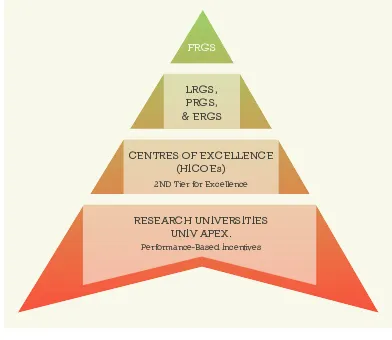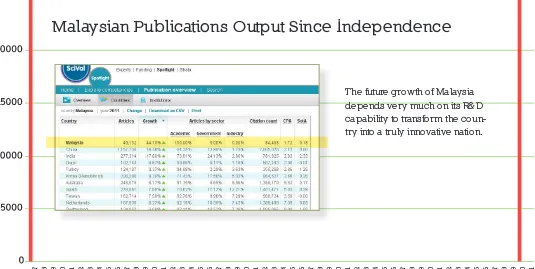by the FRGS evaluation panel, applications for research funding must show elements of new knowledge generation. It is through this mechanism that MOHE has charted a new approach in managing and executing R&D activities relevant to the future needs of the nation. his shift is signiicant because the way MOHE and other funding agencies allocate and monitor research grants will strongly inluence how research is carried out in universities.
Realizing that R&D excellence cannot happen in bits and pieces, MOHE has launched a comprehensive initiative to create synergistic eforts in promoting R&D excellence throughout Malaysia. Besides the FRGS grant, participating programs include the Research University (RU), Higher Institutions Centre of Excellence (HICOE), and the Long Term Research Grant Scheme (LRGS). See Figure 1.
To secure the new incentives MOHE provides, all parties interested in conducting research in Malaysia, including university administrators, research oices, research groups and individual researchers, must now work together in cohesive multi-disciplinary and multi-institutional teams. In an efort to emphasize this shift to consortium-based research, the Malaysian Minister of Higher
By mohd Jailani mohd Nor, universiti Teknikal malaysia melaka
The malaysian experience:
A new approach in managing
multi-disciplinary research projects
10 | The Academic executive Brief - Volume 2, Issue 2 | 2012
In Malaysia, establishment of the National Higher Education Strategic Plan (NHESP) has initiated a national efort to drive research and development (R&D) excellence from within the Ministry of Higher Education (MOHE).
Launched in August 2007 by Prime Minister Abdullah Ahmad Badawi, the NHESP consists of seven components, including Improving Teaching and Learning; Accessibility to Higher Education; Internationalization; Strengthening Institutions of Higher Learning; and Enhancing Research and Innovation.
Because MOHE is a major grant provider to Malaysian research institutions, establishment of the NHESP has made it possible to systematically set comprehensive guidelines for management of funding, standards for research conduct, instruments for research performance, and standardized reporting of research and innovation output. his new approach in the management of research initiatives at the ministry level has created positive ramiications for universities, research management centers, and research leaders. MOHE also acts as custodian of fundamental research in Malaysia through its Fundamental Research Grant Scheme (FRGS). To be approved
Education introduced a new slogan for R&D activities: “WORKING FOR MALAYSIA: hrough Sharing of Resources.”
Before any meaningful outcomes can be achieved, however, a few challenges must be addressed. he irst and most important of these is changing the mindset of researchers and research managers. As standards of R&D excellence rise, demand is
expected to increase for publication, intellectual properties and commercialization of research products. Consequently, researchers must upgrade the way they plan, manage, and conduct research and monitor research performance. Quality control measures have been put in place at each stage of the research process to ensure that projects are managed professionally, using transparent evidence-based reporting, clear accountability and standard performance measures.
MOHE also utilizes a special tool called the Malaysian Research Assessment Instrument (MyRATM) to monitor R&D performance at the institutional level. Regular quarterly meetings
http://Academicexecutives.elsevier.com | 11
Figure 1: malaysian ministry of Higher
education R&D excellence Programs
“These parties are
now entrusted with
the responsibilities
of collaborating
to develop a
research niche
that serves the
nation, and
upgrading their
performance
to be at par
with their
international
peers.”
between MOHE and the research managementoices of higher learning institutions provide a forum to discuss and sort out issues that may arise, including any needed clariication of policy matters.
Numerous additional eforts and initiatives have been put in place to encourage and foster esprit de corps among researchers, where research groups and research institutions are required to work together as cohesive teams. hese parties are now entrusted with the responsibilities of collaborating to develop a research niche that serves the nation, and upgrading their performance to be at par with their international peers.
For instance, within the Long Term Research Grant Scheme, a research team must consist of members from at least three institutions. To ensure that they pursue their research topic from a comprehensive perspective, the team must also include researchers from both soft sciences (social sciences and humanities) and hard sciences (science and technology).
Similarly, the HICOE program requires research institutes selected for funding to be among the top in the country, as determined by three stages of rigorous evaluation and audits. Grantees are also expected to incorporate research groups from other local institutions working within the same research area, and to demonstrate professional management through evidence of efectiveness and eiciency in day-to-day delivery. Together these collaborating institutions must develop their research capacity and upgrade their infrastructure to foster research sustainability for the long run.
FRGs
lRGs, PRGs, & eRGs CeNTRes oF eXCelleNCe
(HICoes)
2ND Tier for excellence
ReseARCH uNIVeRsITIes uNIV APeX.
12 | The Academic executive Brief - Volume 2, Issue 2 | 2012
“similar upward
trends can be
seen from other
indicators such
as ... the number
of research
collaborations
established
with prominent
research groups
all over the
world.”
The malaysian experience: A new approach
continued
properties registered; the number of RUs, HICOEs, Ph.D. holders, and accredited research laboratories; and the number of research
collaborations established with prominent research groups all over the world. Many challenges remain, such as increasing the amount of research grant funding, involving industry partners in R&D activities, commercializing R&D products, and having a direct socio-economic impact via R&D initiatives. hese coming advancements will ensure that Malaysia can progress gracefully towards becoming a developed nation, which embraces the new era of the knowledge-based economy. he future growth of Malaysia depends very much on its R&D capability to transform the country into a truly innovative nation. n
hese requirements are intended to ensure successful research programs based on depth of expertise, not only in academic matters, but also in management and leadership.
During the irst cycle (2006–2010) of these research initiatives, and now into the second phase (2011–2015), positive outcomes have started to emerge. hese include an increase in generation of articles published in reputable journals worldwide. Currently, Malaysia is recognized for achieving the world’s fastest growth rate in numbers of journal publications (Figure 2). A continuing positive trend indicates that this phenomenal growth may be sustained for the next few years.
Similar upward trends can be seen from other indicators such as the number of new intellectual
Figure 2: malaysia’s publication output growth rate tops global list
malaysian Publications output since Independence
source: scopus and sciVal spotlight

